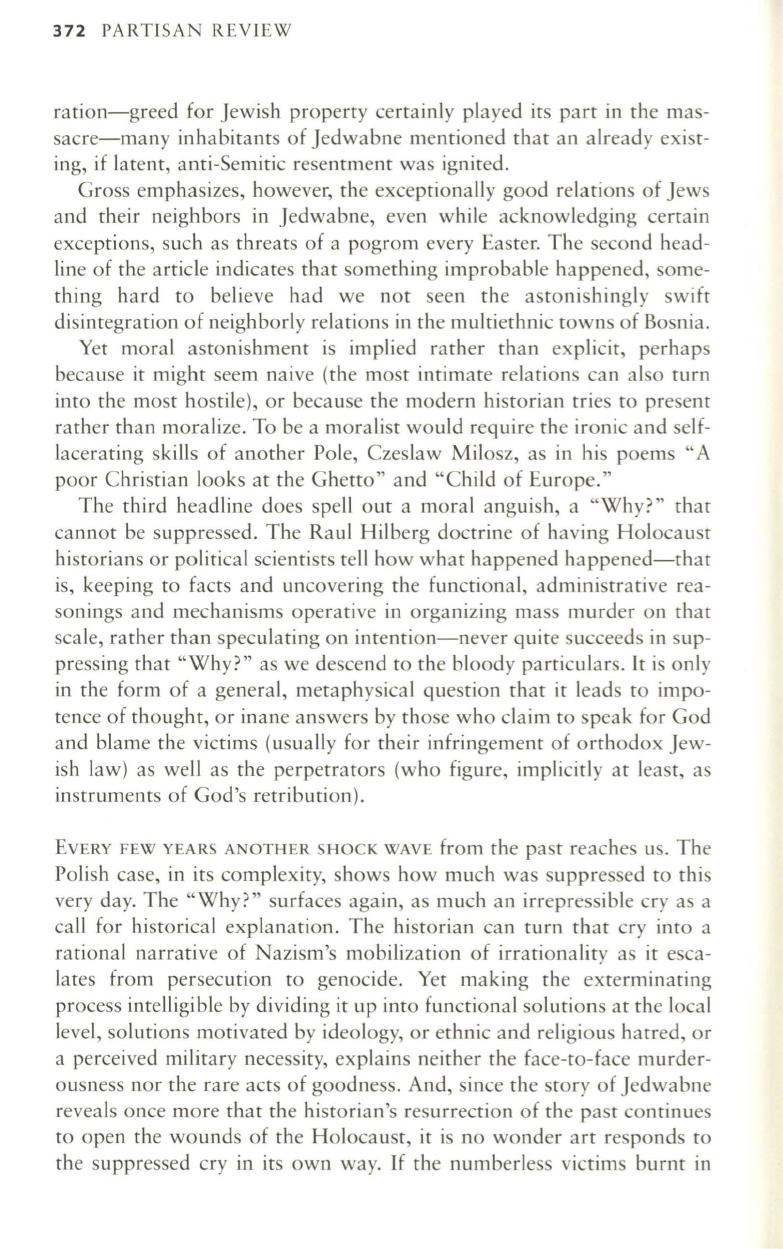
372
PARTISAN REVIEW
ration-greed for Jewish property certainly played its part in the mas–
sacre-many inhabitants of Jedwabne mentioned that an already exist–
ing, if latent, anti-Semitic resentment was ignited.
Gross emphasizes, however, the exceptionally good relations of Jews
and their neighbors in Jedwabne, even while acknowledging certain
exceptions, such as threats of a pogrom every Easter. The second head–
line of the article indicates that something improbable happened, some–
thing hard to believe had we not seen the astonishingly swift
disintegration of neighborly relations in the multiethnic towns of Bosnia.
Yet moral astonishment is implied rather than explicit, perhaps
because it might seem naive (the most intimate relations can also turn
into the most hostile), or because the modern historian tries to present
rather than moralize. To be a moralist would require the ironic and self–
lacerating skills of another Pole, Czeslaw Milosz, as in his poems "A
poor Christian looks at the Ghetto" and "Child of Europe."
The third headline does spell out a moral anguish, a "Why?" that
cannot be suppressed. The Raul Hilberg doctrine of having Holocaust
historians or political scientists tell how what happened happened-that
is, keeping to facts and uncovering the functional, administrative rea–
sonings and mechanisms operative in organizing mass murder on that
scale, rather than speculating on intention-never quite succeeds in sup–
pressing that "Why?" as we descend to the bloody particulars.
It
is only
in the form of a general, metaphysical question that it leads to impo–
tence of thought, or inane answers by those who claim to speak for God
and blame the victims (usually for their infringement of orthodox Jew–
ish law) as well as the perpetrators (who figure, implicitly at least, as
instruments of God's retribution).
EVERY FEW YEARS ANOTHER SHOCK WAVE from the past reaches us. The
Polish case, in its complexity, shows how much was suppressed to this
very day. The "Why?" surfaces again, as much an irrepressible cry as a
call for historical explanation. The historian can turn that cry into a
rational narrative of Nazism's mobilization of irrationality as it esca–
lates from persecution to genocide. Yet making the exterminating
process intelligible by dividing it up into functional solutions at the local
level, solutions motivated by ideology, or ethnic and religious hatred, or
a perceived military necessity, explains neither the face-to-face murder–
ousness nor the rare acts of goodness. And, since the story of Jedwabne
reveals once more that the historian's resurrection of the past continues
to open the wounds of the Holocaust, it is no wonder art responds to
the suppressed cry in its own way.
If
the numberless victims burnt in


